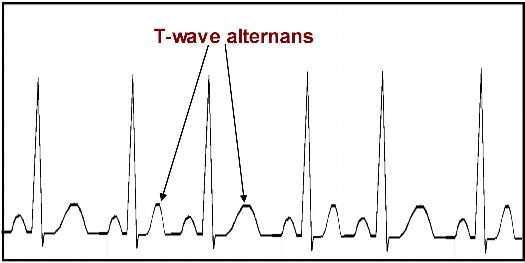Microvolt T-wave alternans (MTWA)
T-wave alternans (TWA) refers to the “beat-to-beat” variability in the surface 12-lead t-wave shape and timing. This variability in ventricular repolarization (as represented by the t-wave) can rarely be seen on a macroscopic level, and is a reflection of a heterogeneous myocardial tissue that can initiate and perpetuate reentrant ventricular tachycardia.

Figure 1. EKG strip representing t-wave alternans (TWA) on a macroscopic level. Note the alternating t-wave timing and shape indicative of this finding.
Recent computerized techniques have allowed for filtering of the t-wave on a “microvolt-level” (hence, microvolt t-wave alternans – MTWA), allowing greater applicability of testing. These visually unapparent alternations of the t-wave on the “microvolt-level” have proven to noninvasively predict the risk of developing life-threatening ventricular arrhythmias and sudden cardiac death (SCD). As a risk-stratification, or adjunctive tool, MTWA can assist your physician in categorizing you in a risk category that would subsequently benefit from more intensive therapy and possible intervention with an implantable cardioverter defibrillator (ICD) in the appropriate clinical scenario. Much of the focus of MTWA has been in higher-risk patients with a history of coronary disease, myocardial infarctions, and depressed ejection fractions.
Clinically, the MTWA study is performed at higher heart rates than baseline.

This necessitates performing the electrocardiographic study on an exercise treadmill, or during an electrophysiology study (EPS) with cardiac pacing. The primary indication for MTWA as approved by the United States Food and Drug Administration (FDA) is for the prediction of ventricular tachyarrhythmias in patients at risk for sudden cardiac death. The primary strength of the MTWAstudy is in its ability to identify a lower-risk subgroup of a high-risk population who have a negative study. At this time, MTWA has the potential to be an adjunctive tool that may aid in the clinical decision-making of ICD implantation in a larger high-risk population that may have low-risk subgroups. Further studies are in progress to clarify and expand its utility.





 Silver Spring Office
Silver Spring Office  DC Office (at Providence Hospital)
DC Office (at Providence Hospital)  Hagerstown Office
Hagerstown Office